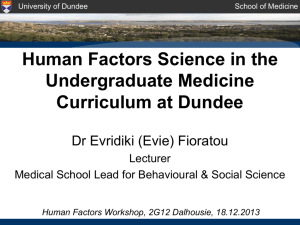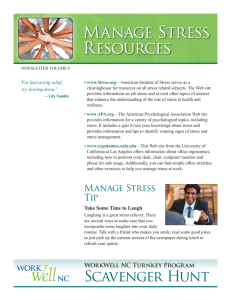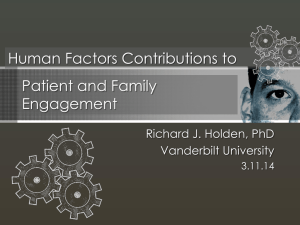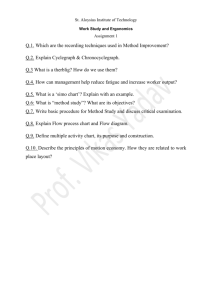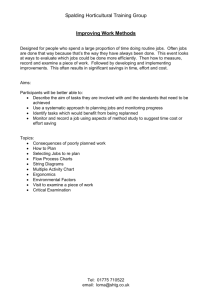California Patient Safety Action Coalition (CAPSAC)
advertisement
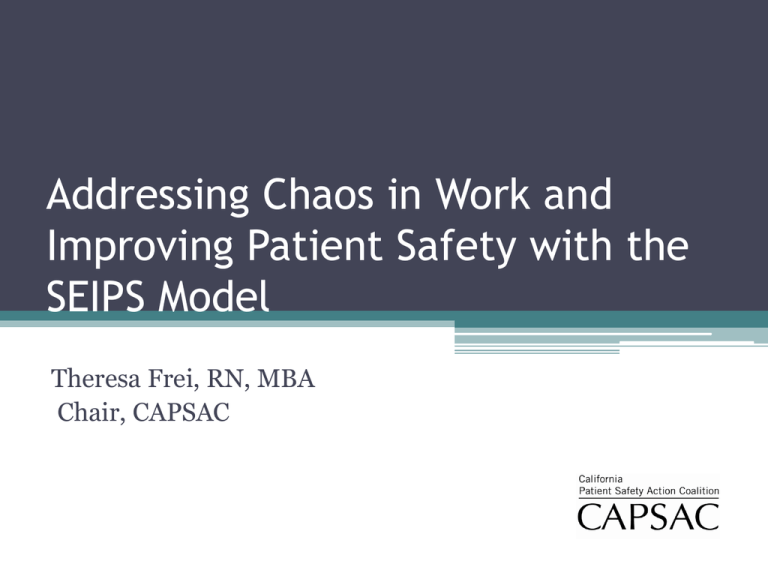
Addressing Chaos in Work and Improving Patient Safety with the SEIPS Model Theresa Frei, RN, MBA Chair, CAPSAC “Finally, systems-engineering knowhow must be propagated at all levels; PCAST recommends that the United States build a health-care workforce that is equipped with essential-systems engineering competencies that will enable system redesign. Implementation of these strategies bears potential not only to improve the efficiency of care delivery, but also to improve its quality. PCAST hopes that this report will provide a framework that helps the Administration achieve these aims as it proceeds with ACA implementation.” ……the President’s Council of Advisors on Science and Technology Objectives • Describe the System Engineering Initiative for Patient Safety (SEIPS) framework for proactive and reactive system design • Review recent survey outcomes on Newly Licensed Registered Nurses and Physicians in Group Practice • Provide information on the collaboration between the CAPSAC and the SEIPS Program Acknowledgements • Pascale Carayon, Ph.D., Center for Quality and Productivity Improvement; Department of Industrial and Systems Engineering, University of Wisconsin-Madison: Presentation to July 2014 CAPSAC Membership • SEIPS 2.0: a human factors framework for studying and improving the work of healthcare professionals and patients; Holden, et al Ergonomics 2013 • RN Work Project 2012; a national study of new nurses, focusing on career changes and work attitudes; New York University, Christine T. Kovner, PhD, RN FAAN; Carol S. Brewer, PhD, RN, FAAN Distinguished Professor http://cqpi.engr.wisc.edu/ Human Factors and Systems Engineering to Improve Patient Safety Pascale Carayon, Ph.D. Center for Quality and Productivity Improvement Department of Industrial and Systems Engineering University of Wisconsin-Madison In 1985… • CQPI was created by Professors George Box and Bill Hunter. • Tradition of community involvement April’2010 Celebration of 25th anniversary of CQPI http://cqpi.engr.wisc.edu/ CQPI Today… SEIPS or Systems Engineering Initiative for Patient Safety Originally funded by AHRQ in 2001: Developmental Center for Education and Research in Patient Safety 1 out of 18 centers funded Only center in engineering Why don’t people do a good job? Why do people keep making mistakes? … because of the poor design of work systems http://cqpi.engr.wisc.edu/seips_home [SEIPS = Systems Engineering Initiative for Patient Safety] SEIPS Model of Work System and Patient Safety Carayon, P., Hundt, A.S., Karsh, B.-T., Gurses, A.P., Alvarado, C.J., Smith, M. and Brennan, P.F. (2006) Quality & Safety in Health Care Carayon, P., Wetterneck, T.B., Rivera-Rodriguez, A.J., Hundt, A.S., Hoonakker, P., Holden, R. and Gurses, A.P. (2014) Applied Ergonomics Human Factors and Ergonomics • System from the viewpoint of users • Users have physical, cognitive and psychosocial needs • User-centered design HFE sub-disciplines & topics • Physical ergonomics ▫ Working postures, materials handling, repetitive movements, work-related musculoskeletal disorders, workplace layout, safety and health. • Cognitive ergonomics ▫ mental workload, decisionmaking, skilled performance, human-computer interaction, human reliability, work stress and training as these may relate to human-system design. • Organizational ergonomics ▫ optimization of sociotechnical systems, organizational structures, policies, and processes, teamwork, scheduling, coordination/communication • • • • • • • • • • • • • • • • Usability Mental workload Situation awareness Human-automation interaction Alerts Lifting Training Teamwork Information processing Naturalistic decision making Handoffs Interruptions and distractions Violations or work-arounds Human error Safety Job stress Faster; better visibility, usability and organization HFE Design (Rousek & Hallbeck, 2011) ICU Displays Koch et al. (2013) Anders et al. (2012) (Anderson et al., 2010) Workload Awareness Performance obstacles reported by ICU nurses (Gurses & Carayon, 2007) Need to understand work systems Systems in which they work Systems in which they work Who are the ‘users’? SEIPS 2.0 Principles • System Orientation • Person Centeredness • Design-Driven Improvements SEIPS 2.0 • Holden, R.J., Carayon, P., Gurses, A.P., Hoonakker, P., Hundt, A.S., Ozok, A.A. and Rivera-Rodriguez, A.J. (2013) Ergonomics How Are We Doing on Person Centeredness? RN Work Project Unsafe, poorly managed and poorly equipped work environments hold Newly Licensed RNs back • 25% reported at least one on-the-job needle-stick • 39% reported at least one strain or sprain • 21% reported a cut or laceration • 46% reported a bruise or contusion • 62% reported verbal abuse RN Work Project NLRNs work long hours • Almost 13% worked mandatory overtime • 51% worked voluntary overtime NLRNs don’t leave nursing, but they do leave their employers • 41% planned to leave their first job within 3 years • 18.1% left their first nursing job within 13 months of starting • 26.2% left their first nursing job within 25 months of starting Why do NLRNs leave their first job? • Top 3 professional reasons: poor management, stressful work, wanting experience in another clinical area • Top 3 personal reasons: moving to a different geographic area, partner takes a job elsewhere, compatible school schedule American Medical Group Association Physician Satisfaction Survey- 2014 Quality Care % Very Satisfied Quality of care you are able to provide 60% Your ability to obtain specialty referrals whenever you feel they are necessary 45% Your ability to prescribe the medications you want 42% Your ability to obtain tests or procedures for patients whenever you feel they are necessary 47% Your ability to refer patients to high quality specialist 50% American Medical Group Association Physician Satisfaction Survey-2014 Time Spent Working % Very Satisfied Time you have available for your family and personal life 28% Degree of control you have over your schedule 35% Amount of time you spend working 24% Amount of time you spend with each patient 32% The volume of my patient load or panel size is reasonable 21% Resources For Care Medical supplies are available when I need them 34% I have sufficient exam room space to see my patients 44% I have adequate equipment for office procedures 35% Sutter Medical Group – Interventions Work! 100% 90% 80% 80% 77% 70% 70% 63% 60% 50% 78% 60% 54% 55% 52% 44% Post 40% 30% 20% 10% 0% Documenting General Sutter using the Sutter In Basket EHR Knowledge EHR Management Pre Medication Management Order Entry Management & Use Shortcuts CAPSAC And SEIPS CAPSAC 2013Confirmed Future Direction • Continued partnership with CDPH on discussing regulations to increase reporting • Education and assessment of human factors in our processes ▫ Decrease harm related to human error ▫ Increased ratio of reports not resulting in harm • Improve communication related to errors/omissions • Engagement of the public to better understand the role of human error in patient safety CAPSAC-- 2014 • CAPSAC’s role is to provide a forum for organizations to address patient safety and leverage change across the healthcare continuum based on the principles of a fair and just culture. Three Pillars • Provide opportunities for health care organizations to share best practices; and establish a mechanism for shared learning across organizations to minimize the same errors from occurring again. • Educate regulatory agencies, legislators, consumers, healthcare providers, purchasers of healthcare, and the media. • Serve as a resource to the Department of Public Health, the Center for Healthcare Quality, patient safety institutions, and professional licensing boards Human Factors and Systems Engineering for Medication Safety May 11-13; 2015 International Experts in Human Factors and Systems Engineering, Medicine and Patient Safety Course on Human Factors and Systems Engineering for Medication Safety This 2 ½ -day course for healthcare professionals presents internationally recognized speakers discussing a variety of Human Factors Engineering (HFE) and medication safety topics. Day 1: Introduction to human factors engineering and its application to medication safety; Physical environment; Human factors analysis of medication use process Day 2: Cognitive ergonomics; Technology design, implementation and usability; Case study Day 3: Organizational design and resilience; Case study reporting; Moving forward with SEIPS approach For course information email Theresa Frei at CAPSAC: FreiTh@sutterhealth.org Sponsored by the California Patient Safety Action Coalition
